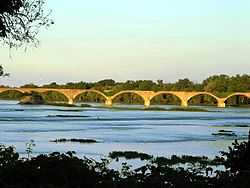Interurban Bridge
|
Interurban Bridge | |
 | |
|
Interurban Bridge and Roche de Bout | |
 | |
| Nearest city | Waterville, Ohio |
|---|---|
| Coordinates | 41°29′11″N 83°43′42″W / 41.48639°N 83.72833°WCoordinates: 41°29′11″N 83°43′42″W / 41.48639°N 83.72833°W |
| Built | 1908 |
| Architect | National Bridge Co. |
| Architectural style | Other |
| Governing body | State |
| NRHP Reference # | 72001036 [1] |
| Added to NRHP | June 19, 1972 |
The Interurban Bridge, also known as the Ohio Electric Railroad Bridge. is a historic interurban railroad reinforced concrete arches bridge built in 1908 to span the Maumee River joining Lucas and Wood counties near Waterville, Ohio. It is now a part of Farnsworth Metropark. One of the bridge's supports rests on the Roche de Boeuf, a historic Indian council rock. This was partially destroyed by bridge construction.[2]
Builder Lima-Toledo Traction
The bridge has been abandoned for many years. It was constructed by the Lima-Toledo Traction company, an interurban trolley line that ran primarily adjacent to the Baltimore and Ohio steam railroad from Toledo to Lima, Ohio. Many Ohio interurban lines struggled financially from inception. In an attempt to create operational efficiency under one management, the L-T was brought under lease control of the Ohio Electric corporation along with other Ohio interurbans to form a large widespread Ohio interurban network. All equipment was relettered and operated as the Ohio Electric.[3] Itb didn't work, and when the OE went bankrupt, the L-T returned to its former owners as the Lima-Toledo Railroad which continued interurban service between Toledo and Lima.
Final use by the Cincinnati and Lake Erie Railroad
In 1929, two adjacent Ohio interurbans (the Cincinnati Hamilton and Dayton, and the Indiana, Columbus and Eastern) combined with the L-T to form the Cincinnati and Lake Erie Railroad to establish interurban service from Toledo to distant Cincinnati. A branch operated from Springfield to Ohio's capitol Columbus.[4]. The goal was to increase passenger business and particularly interurban freight business in a heavily industrialized part of Ohio. From 1929 to 1930, the C&LE (see Wikipedia, C&LE) borrowed heavily to rebuild track and purchase new passenger and freight equipment in order to provide high speed operation between its major cities of Toledo, Lima, Springfield, Dayton, and Cincinnati. (See Red Devils.) Initially the C&LE was successful, but the collapsing national and local economy due to the Great Depression of the 1930s, numerous very expensive repairs due to floods, the paving of highways, and the rapid growth of automobile and truck ownership and use forced abandonment in 1939. This was the last year th,at the Interurban Bridge saw rail traffic.[5] On June 19, 1972, it was added to the National Register of Historic Places
Reference and notes
- ↑ "National Register Information System". National Register of Historic Places. National Park Service. 2008-04-15.
- ↑ Waterville history page
- ↑ Keegan: chapter 1
- ↑ Keenan: ch. 2 and map.
- ↑ Keegan: ch 6
Bibliography and further reading
Keenan, Jack: The Cincinnati and Lake Erie Railroad: The Great Ohio Interurban. 1974. pp 226. Golden West Books, San Marino, Calif
Middleton, Wm D: The Interurban Era. pp 330; 1962, Kalmbach Publishing. Milwaukee, WI.ISBN 0-8902-4003-5
Middleton, Wm D: The Last Interurbans. Central Electric Railfans Association, Chicago, IL.
Professor George Hilton: 1957. The Interurban Electric Railway in America. Stanford Univ Press, California.
Rowsome, Frank: Trolley Car Treasury, pp 209, Bonanza Books, New York, New York.
| ||||||||||||||||||||||||||
Template:WoodntyOH-NRHP-stub